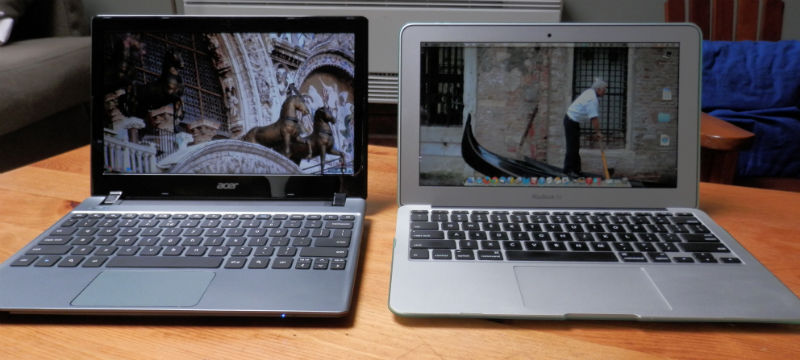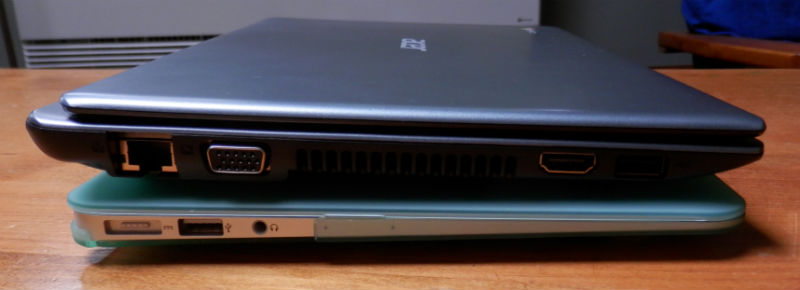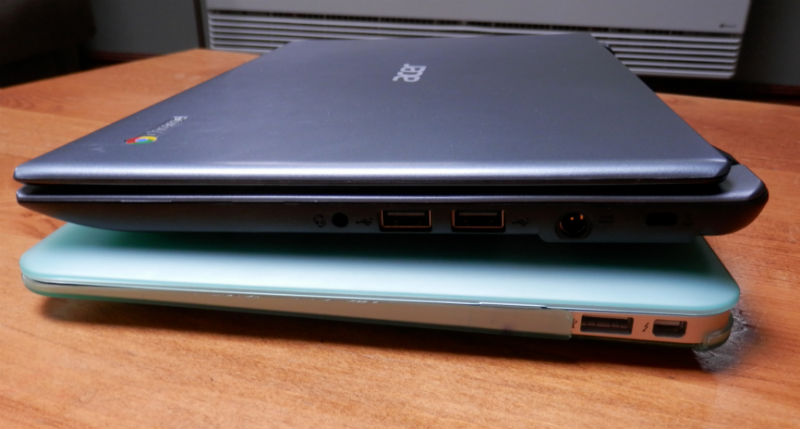I bought a Chromebook. Back in April, I reviewed a loaner Chromebook, a CDN$269 Samsung model. Overall, I enjoyed the experience; the hardware was reminiscent of an 11” MacBook Air ultralight notebook with many limitations – partly the result of the dramatically lower price point and partly due to running Google’s Chrome OS, an operating system based on the Chrome browser.
 You can’t run standard Mac or Windows applications, and even though Chrome OS is related to Linux, you can’t even run standard Linux applications. Instead, you boot – quickly – to the Chrome browser, and everything runs in a browser tab or window.
You can’t run standard Mac or Windows applications, and even though Chrome OS is related to Linux, you can’t even run standard Linux applications. Instead, you boot – quickly – to the Chrome browser, and everything runs in a browser tab or window.
That means that you really want to be online. But that’s less of a limitation than you might think – after all, most of us are online most of the time. And for those other times, Chrome OS offers options to make use of various Google services – Gmail and Google Docs, for instance – offline, syncing changes with the cloud-stored services next time you’re connected.
After returning the Samsung Chromebook, I was taken enough with Chrome OS that I installed its open source relative Chromium onto a Dell Mini 9 netbook that was otherwise mostly sitting on a shelf. (See my post on Low End Mac). But while that worked, the netbook still spent most of its time on the shelf. Chromium is unsupported by Google, so it doesn’t automatically get updated when Chrome does. And the Mini 9, like other netbooks of its 2008-era has a small screen, trackpad and keyboard and a slow Atom processor – it’s at best a bit awkward to use.
Under $200
But when I saw Acer’s C7 Chromebook, regularly US$199, on sale for US$129, I went for it. It arrived a few days ago.
Like the Samsung model (and Apple’s 11” Macbook Air), its got an 11.6” display with a screen resolution of 1366 x 768 pixels – not a super high resolution ‘Retina’ display, but good enough. A ‘chiclet’ keyboard and large trackpad. (Again, like both Samsung’s Chromebook and the Macbook Air). 2 GB of memory.

Acer C7 Chromebook vs 11″ Macbook Air
The C7 uses a dual-core Intel Celeron CPU, a big step down from the current Air’s Core i5 or i7 CPUs. The 11” Macbook Air comes standard with a 128 GB solid state drive (SSD). Samsung’s Chromebook also comes with an SSD – a much more modest 16 GB one. Acer took another route – its C7 Chromebook comes with a 320 GB conventional hard drive.
There are some pluses and minuses to that decision.
Solid state drives are faster than conventional drives. Still, because of Chrome OS’s minimalist nature, even with its standard hard drive, the C7 boots to its log on screen in 16 seconds. After entering my password, it’s ready to go in just a few seconds more. And lacking applications in the conventional sense, there’s not much drive-related waiting for programs to load.
That 320 GB drive offers much more storage than Samsung’s 16 GB SSD – but then, Chrome OS is oriented towards getting users to make use of cloud services. Google gives two years of 100 GB of Google Drive storage to Chromebook purchasers. On the other hand, Google’s Music Manager service, allowing iTunes users and others to upload 20,000 songs to the cloud for free for access by multiple devices, isn’t available to me outside the US, so it may turn out to be handy for me to have more storage on this device.
Then again, SSDs are much more robust and reliable than conventional hard drives. If the justification of a small, light notebook-like device is to be able to throw it in a bag and take it everywhere, I’d feel much more comfortable with a solid state drive with no moving parts.
Comparing the $199-list Acer C7 Chromebook with the $999 (and up) 11” Macbook Air is unfair. But I’m going to make a few more comparisons anyway. The two devices are roughly the same size – the Air is a bit wider, the C7 is thicker. The Air is built with Apple’s standard slick aluminum unibody construction, the C7 with dark grey plastic. The C7 weighs in at 3 pounds – quite a bit more than the 11” Air’s 2.4 pounds (though about the same as the larger 13” Air).

Acer C7 Chromebook on top of 11″ Macbook Air
While at a quick glance the keyboard and trackpad of the two devices look similar, the Air feels much nicer to use; in particular, two-finger scrolling on the C7’s trackpad feels sluggish compared to gliding along the Air’s glass trackpad. But both the keyboard and trackpad on the C7 are far superior to those on my (several year-old) Dell Mini 9 and 10 netbook.
Battery life is far better on the Macbook Air – the use of Intel’s new Haswell CPU and chipset on the current-generation Air lets the 11” model promise 9 hours of use on a charge. The C7’s (removable) battery is smaller and its processor is less optimized for energy efficiency; as a result, the Acer Chromebook promises only 3.5 hours or so of battery life on a charge. (I’ve actually been getting closer to 4 hours mixing word processing with email and light web browsing).
By using a more energy-efficient solid state drive and Intel Atom CPU, Samsung’s Chromebook model promises 6.5 hours on a charge. (As always, actual battery life will vary depending on both the tasks being performed and the number of times the battery has been recharged – battery capacity diminishes over time).
Compared to Apple’s high-priced model, though, the Acer offers more ports. The C7 includes both standard VGA and HDMI video outputs for connection to TVs and digital projectors – Apple’s Air forces users to purchase an adaptor. The C7 has an ethernet port for wired networking; again, Air users need to purchase a USB or Thunderbolt adaptor. The 11” Air has two USB ports (USB 3.0, mind you); the C7 has three (slower USB 2) ports. The C7 has an SD memory card slot, something included in the 13” Air but not its 11” sibling. And C7 users can lock it down with a Kensington-style cable-lock – something not supported on the Air, which at five times the cost is much more of a theft-magnet.

Acer C7 Chromebook on top of 11″ Macbook Air
Even with its wealth of ports, it’s hard to avoid the conclusion that physically, the Acer C7 Chromebook is a cheap imitation of an 11” Macbook Air – and that in many respects you get what you pay for.
But cheap has its charms. If the 11” Macbook Air’s $999 price (higher if you upgrade the RAM, storage, and/or processor) is outside your budget, the C7 – priced at $200 (or less – remember, I paid $129) price may be worth considering. And there are times when cheap technology really shine.
For instance, I’m going to be travelling next month. If my gear gets stolen, I’ll be much less unhappy if it’s a sub-$200 Chromebook than an over-$1000 Macbook Air.
Is It Truly Useful?
Regardless of price, though, any gadget is only worth getting if you can actually use it. There’s no doubt that Google’s Chrome OS is limited compared to a full desktop-style OS like Mac OS X, Windows, or Linux. But how limiting is it really?
Probably 80% of the times I go to a computer – or tablet, for that matter – I’m checking email or going online, either to see what’s new on my various social networks. Maybe a quick fact-check on Wikipedia. There’s little or no difference doing that using a Chromebook or a more standard notebook or desktop.
Other times, I may be writing or accessing a saved spreadsheet or other document. Right now, for instance, I’m writing this article.
I’m doing it on the C7 Chromebook using Google Docs and storing it on my Google Drive. For this basic writing, it’s not vastly different than it would be using, say, Microsoft Word and storing my file on my local hard drive. If I’d ever warmed up to Apple’s Pages word processor, I could be using that, since Apple has recently made the iCloud beta-version of Pages (and the other iWork applications) available to everyone with an Apple account.
Since I use Google services for email, calendar, online storage, and more, Chrome OS (like Android) works especially well for me – my bookmarks, saved passwords, and more are all there – just as they are when I use the Chrome browser on a Mac or Windows system.
I’m surprised at how capable the online Pixir Editor is for photo editing – I used it to crop and resize the photos for this article. There may be equally capable online sound and video editing options that I’m not aware of, though; next week, when I’ll be shooting video at a music performance of mine, I’ll probably edit the clips on my Mac – yes an 11” Macbook Air – prior to uploading them to YouTube. I could probably do that online from the Chromebook if I really had to, though.
When I’m ready to post this onto my own blog, I’ll open it on my Mac – yes, an 11” Macbook Air – and upload it (as an HTML file) to my website; I’ve posted it on Low End Mac’s site right from the Chromebook, using LEM’s online WordPress interface.
So the case for Chrome OS is rather similar to the case for a tablet – it’s not a full replacement for a ‘real’ desktop or notebook computer, but it can probably do the job for a surprisingly large percentage of what you are currently using your computer for – at least if you’re not a gamer.
And as I said up above, cheap has its charms.
Keywords: #chromebook #macbookair
Short link: http://goo.gl/lBzAr0


The $249 Samsung series 3 Chromebook uses an arm processor, not an Atom.
The original Samsung Chromebook – which I’d had for review – the series 5, used a dual-core 1.66GHz Atom N5770 (http://www.maximumpc.com/samsung_chromebook_review). The current model has an ARM-based (Samsung manufactured) 1.7GHz Exynos 5 CPU.
Thanks for the correction.